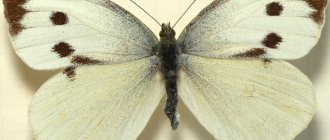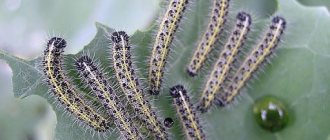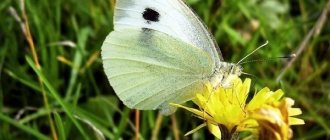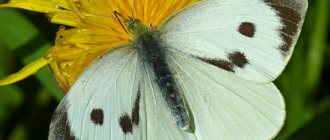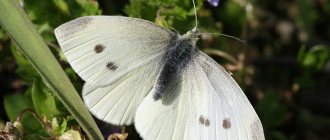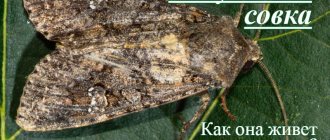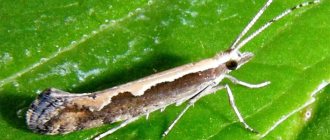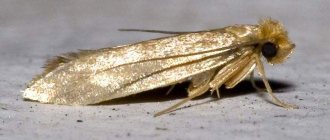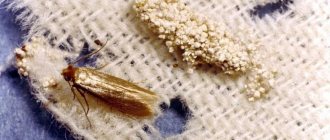Origin of the species and description
The name, both Latin and Russian, indicates that the main food plant of the larvae is cabbage. The wings of these lepidopterans are white, as is also evident from the name. The cabbage plant has two more close relatives - the turnip and rutabaga; they are similar in appearance, but the cabbage plant is larger. Its size can be compared with another whitethorn, also a related species, the hawthorn, but it does not have black markings. Found throughout almost all of Eurasia, they migrate in some regions. In northern latitudes, their numbers become significantly larger in the summer, due to migrations from the southern regions. Long-distance and mass migratory flights are atypical for this species, since there is sufficient food supply everywhere, but they can travel up to 800 km.
If a male begins courting a female who has already been previously fertilized, she instantly dives into the grass to hide from the annoying admirer. She closes her wings and remains motionless, relying on her underside camouflage. Usually a suitor can find her, due to the pheromones emitted, quite aggressively trying to force himself on her. At first she responds by swaying slowly from side to side. This is followed by partial opening of the wings, which prevents contact. She raises her abdomen at a steep angle (possibly releasing a chemical deterrent at the same time) to signal her rejection of the mate, and the male flies off.
What does a caterpillar eat?
Many summer residents assume that the white butterfly only harms cabbage plantings, and that other crops are safe - this is a mistaken opinion. The caterpillar of this insect happily eats:
- turnip;
- rutabaga;
- radish;
- rape;
- horseradish;
- garlic;
- radish;
- mustard.
The caterpillars have an excellent appetite. If they are not detected and eliminated in time, they can destroy the entire crop, leaving the farmer with empty beds. A developed olfactory system helps them identify edible and inedible crops.
Appearance and features
The cabbage has white wings with black corners on the front. Females have a pair of black spots on their front wings, they are brighter, and there is also a black teardrop-shaped stripe along the lower edge of the front wings. Along the anterior edge of the first wing, some scales are black; it looks like a smoky stripe. So the black tips, closer to the very corner of the wing, become lighter. In the center of the upper edge of the lower wing there is a black mark, which is not visible when the insect is sitting, since it is covered by the front ones. The underside of the wings of females is pale greenish with dark pollen and there are spots on the forewings. Males have a more buffy underside. When the wings are folded, it serves as good camouflage. In this position, the hind wings almost cover the front ones. Their span is 5-6.5 cm. The antennae are black and white at the top. The head, chest and abdomen are black, with white hairs, and whitish below. The caterpillars are blue-green with three yellow stripes along the body and black dots.
The pupa (2.5 cm) is yellow-green with gray-brown dots. It is belted with a silky thread, which is attached to the leaf. Whitefish are an aposematic species, meaning they have warning colors that ward off predators. Aposematic coloration is present in the larval, pupa and adult stages. They also contain toxic glycosides from mustard oil from food plants. Mustard oils contain sulfur compounds, which impart a pungent odor to the larvae and their droppings. The unpleasant smell repels many birds and insects that might prey on them. The insect has well-developed organs of vision and a fairly acute sense of smell. Club-like thickenings on the antennae and front legs serve as organs of touch. The female, before laying eggs, sits on a leaf of the plant, carefully feels it, testing for suitability, and only after that begins laying.
This species of Lepidoptera is distributed throughout Europe, including the islands of the Mediterranean Sea and the subarctic regions of Scandinavia. Cabbage white is also found in Morocco, Algeria, Tunisia, Libya and throughout temperate Asia up to the Himalayan mountains. It does not occur naturally outside of these regions, but was accidentally introduced to Chile. The appearance of cabbage grass has already been recorded in some regions of South Africa. Great concern was also caused by the fact that these arthropods were discovered in 1995 in Australia, and in 2010 in New Zealand. This pest of vegetable crops has been found several times in the northeastern United States. It is unclear how the butterfly got there; perhaps it arrived illegally with cargo.
The butterfly is well adapted to migration; it has no difficulty in replenishing the population on the islands, as happens in England, where the cabbage fly flies from the mainland. They are often found on agricultural lands, parklands, vegetable gardens and farms, and love open spaces. They can land on fences and tree trunks, but always where there are sources of food nearby for the future generation. In the mountains it rises to a height of 2 thousand m. On sunny days, adult individuals fly from flower to flower, feeding on nectar, and in cloudy weather they sit on the grass or low bushes, with their wings half-open. So they warm up, part of the sun's rays, reflected from the wings, falls on the body.
The winged creatures feed on the nectar of flowers. To do this, they have a proboscis curled into a spiral. They can be seen on: dandelion, meadow greenweed, alfalfa and other flowers. Sources of spring nectar also include tenacious and milkweed, while summer broods prefer: thistle; cornflower; marjoram; I'm awake; scabiosis; hemp. Butterflies lay their eggs on cruciferous vegetables, and they are especially attracted to different varieties of cabbage. Plants with mustard oil glucosides are important for nutrition. These substances give cabbage whites a specific smell that repels enemies. The caterpillars feed cooperatively, quickly consuming leaves, leaving only veins, and then move on to neighboring plants. They are one of the main pests and cause enormous damage to the cabbage family grown in fields and private gardens. These are different varieties and derivatives of cabbage, especially Brussels sprouts, cauliflower, kohlrabi, as well as mustard, rapeseed, a total of 79 types of cruciferous vegetables, including bedbug, zherushnik, and radish. The caterpillars are very fond of the tender leaves of nasturtium and mignonette.
Cabbage whites are one of the first to appear as soon as it gets warmer. Even on cloudy days, when there are still few other insects, they can be seen fluttering over green spaces. They have a rather powerful, wave-like flight, and over obstacles such as bushes, trees, buildings, they easily fly from above or maneuver between them. Once cabbage whites reach a place where there are flowers, they stay there for several days. In sunny weather they make short but regular flights, stopping briefly every few seconds to drink nectar on low-growing flowers. Two generations of butterflies grow up per season. In the southern regions, the first generation occurs in April-May, in the north - a month later. In the second period, more individuals appear; it occurs in the second half of summer. In the south, the development of another generation is possible. Despite the fact that the caterpillar larvae live on the plant on which they feed, the pupae of these insects can be found on tree trunks, fences, walls, at some distance from the food plant. Sometimes pupation occurs on the trunk or leaf of a plant. Most often, the pupa is attached with a thread in a vertical position.
Whitefish are polygamous, but most females have one partner. 2-3 days after copulation, the butterflies lay fairly large pin-shaped ribbed eggs of a pale yellow color (about 100 pieces). During the first day they become bright yellow and quite noticeable against the background of a green leaf. Ten days before the larvae hatch, the eggs darken and the shell becomes transparent. Most often, the laying is done on the back of the leaf, so it is invisible to predators and is not susceptible to solar insolation or precipitation. During the period of development, the larvae go through five instars through four stages of molting: The first is characterized by the fact that the larvae emerge from a light yellow egg with a soft, shaggy body and a dark head. In the second instar, tubercles on which hairs grow become noticeable on the body. In the third instar they become very active, yellow-green in color with black dots, and already cause a lot of damage. The fourth instar is similar to the third, but the caterpillars are already larger, more active, and their body color is greenish-blue. At the fifth instar they become large (40-50 mm), with an elongated body and bright color. During this period, the food supply is especially important.
If the larvae do not receive the best possible food in sufficient quantities, they may die before they become butterflies. Summer individuals do not spend long in the pupal stage, and after 2-3 weeks a new white-winged specimen is born. If pupation occurs at the end of summer or autumn, then they overwinter until spring.
Reproduction
The first stage of reproduction of cabbage whites begins in the second half of April-early May. The males begin to emit a strong odor that attracts numerous females. A pair of butterflies goes through a ritual process of getting to know each other and then mates. The ritual is a joint flight with a change of directions at a distance of 100-150 meters.
Some time after mating, the females begin to lay eggs. The following are selected as food for future offspring:
- cruciferous weeds. This is the main food in the spring, since the seedlings in the garden have not yet grown strong or there are too few of them;
- In summer, cabbage, rutabaga, garlic, radish and rapeseed are selected as food base.
The eggs are attached to the back of the leaf. This technique allows you to protect the masonry from:
- scorching sun;
- rain and wind;
- hostile life forms that feed on immature larvae.
Note! A well-developed sense of smell helps a butterfly choose the optimal plant for creating a clutch.
The clutch size of the white butterfly depends on the environment:
- if everything is calm, up to 200 eggs may appear on one leaf;
- if a white butterfly is scared away, it pauses the process and flies to another plant.
Next, the cabbage white flies away to feed until a new supply of eggs is formed in its abdomen. It takes several days for the larva to emerge from the laid egg.
Stages of development into a butterfly
The stages of development of cabbage whites are as follows:
- the beginning of spring summer;
- pairing;
- the appearance of eggs;
- formation of larvae;
- pupation;
- the beginning of summer.
Flight begins in April, when the weather stabilizes and it becomes warm. The peak of activity occurs in the warm time of day, when the sun warms the air to its maximum. Next, the adults mate and clutches with offspring are formed. It takes about two weeks for a cabbage egg to fully develop.
The larvae that emerge from the eggs take up to 40 days to go through all stages of growth and form into a pupa:
- At the first stage of development, the larvae stay together, eating the top layer of leaves. They do not crawl around the plant, preferring a collective existence.
- As soon as the larva gets stronger, the next phase begins. At this time, it separates from the main group and begins an independent existence. The upper layers of the leaf are no longer enough for food, and the growing individual begins to make through holes. In addition, abundant excrement begins, which poisons the plant and it rots.
- Adult, almost fully formed caterpillars gnaw cabbage leaves clean, leaving only the stringy parts intact. In addition to the leaves, the buds and flowers of the plant, which are also included in the pest’s diet, begin to suffer.
The interval between molting and the duration of larval formation depends on environmental conditions. If nothing interferes with the caterpillar, then the intervals between molts are no longer than 3 days. With poor nutrition, the interval increases to 7 days. In search of food, caterpillars can cover considerable distances and destroy not only yours, but also your neighbors’ property.
The last stage is pupation. It begins a week after the last molt and lasts about a month. The following places are selected for pupation:
- trunks and branches of nearby trees;
- fencing;
- outbuildings.
Once the pupa is fully formed, an adult butterfly hatches from its cocoon, which begins the entire cycle all over again. The summer generation appears in mid-July-early August. Many farmers are wondering how long does an adult cabbage butterfly live? Based on the observations of scientists, we can conclude that the life cycle of an adult does not exceed 30 days.
Note! In regions with warm climates, the number of generations can be increased from two to three.
Fighting methods
Among the effective methods of controlling insects and preventing their occurrence are:
- Hand picking eggs from cabbage leaves. The method allows you to effectively destroy the butterfly population in its infancy. The disadvantages include the cost of time and effort, since it can be extremely difficult to check every leaf in the garden bed.
- Destruction of pupae. If this is not the first time your plantings have been attacked by cabbage weeds, carefully inspect the trunks of nearby trees and other places where pupae may appear.
- Experienced farmers, when the butterfly appears, try to plant cabbage seedlings as early as possible. This helps the crop grow stronger and suffer less damage from pests.
- Try to remove all weeds that belong to the cruciferous family near the plantings. They become the first target of white butterflies, after which their offspring will move to the grown heads of cabbage.
- Plant the following crops next to cabbage: parsley, lemon balm, dill, carrots and eggplant. They repel butterflies, reducing the risk of losing the entire crop.
- There are a number of parasites that do not harm plantings, choosing the bodies of cabbage larvae as their habitat. These include small belly, trichogramma and flascheria.
- In advanced situations, when the plantings and surrounding areas are heavily infested with the white butterfly, chemical control agents are used. They are sold in specialized stores, and purchasing them will not be difficult.

